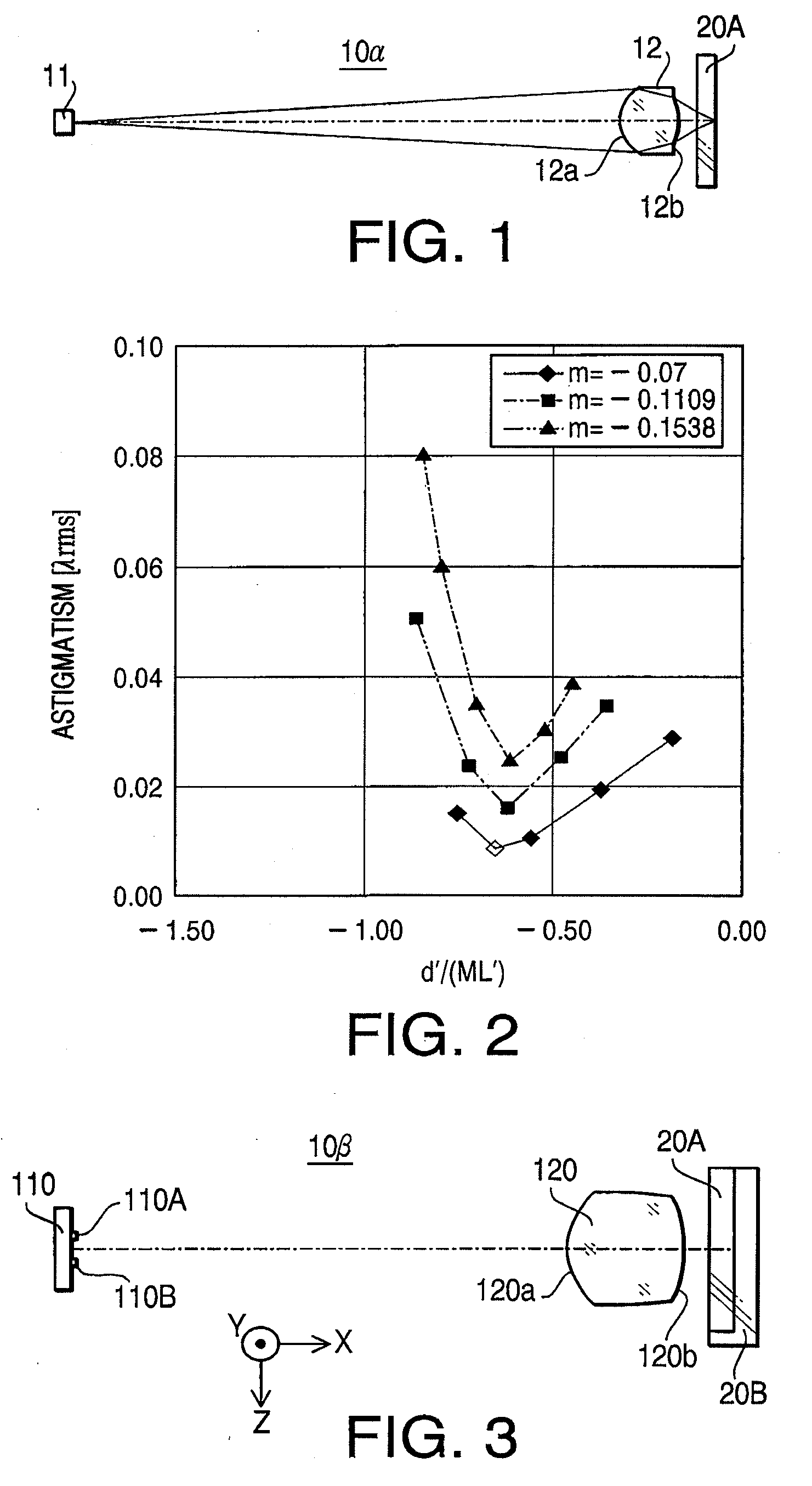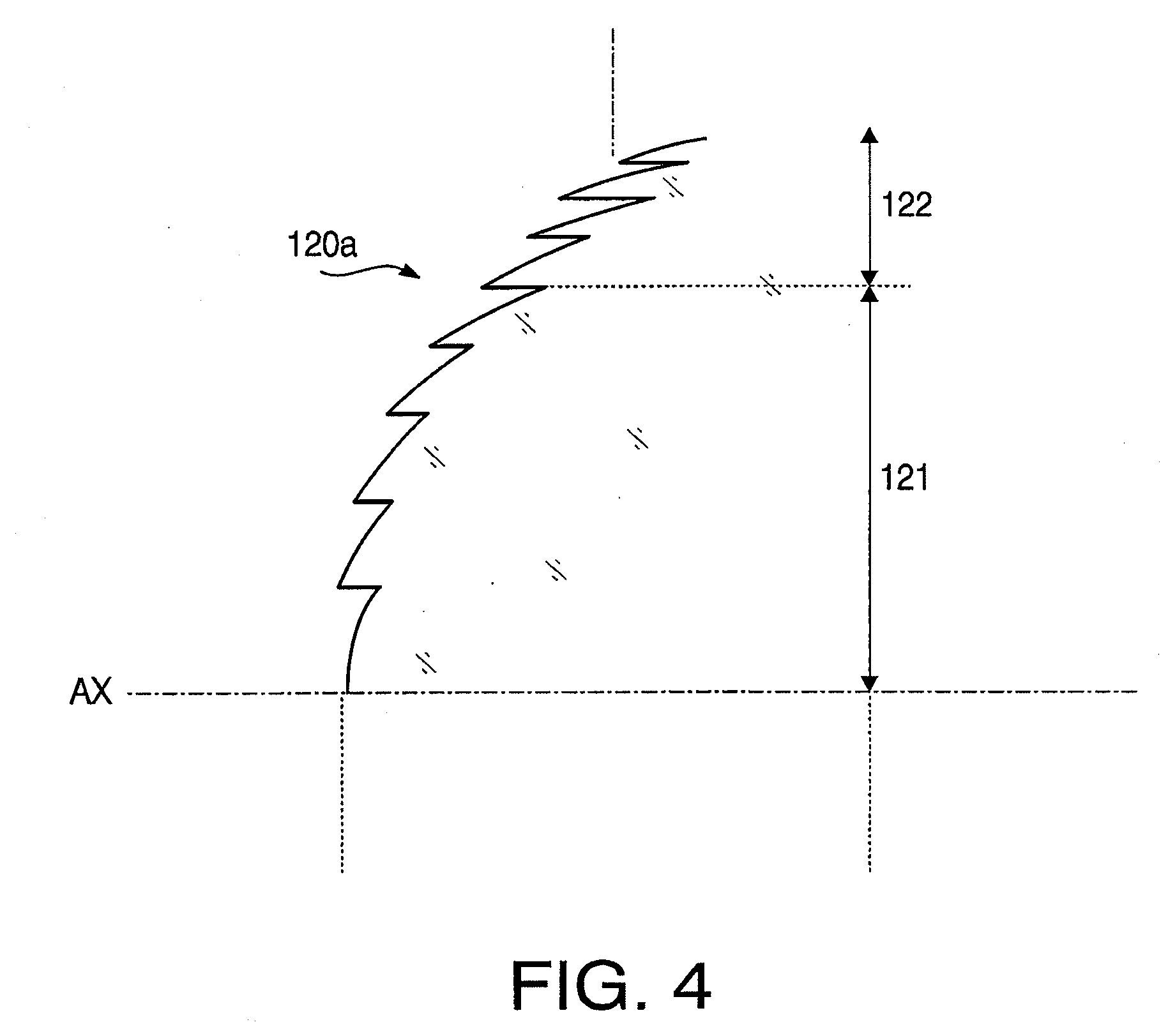Optical system for optical disc drive
an optical disc drive and optical disc technology, applied in the field can solve the problems of off-axis aberration and astigmatism of optical disc drives, and achieve the effect of suppressing off-axis aberration and high recording density
- Summary
- Abstract
- Description
- Claims
- Application Information
AI Technical Summary
Benefits of technology
Problems solved by technology
Method used
Image
Examples
first embodiment
[0038]FIG. 1 is a block diagram of an optical system 10α according to a first embodiment. In FIG. 1, an optical disc 20A having a relatively high recording density and having a relatively thin cover layer (e.g., a DVD) is also illustrated. The optical system 10α includes a light source 11 and an objective lens 12. The optical system 10α is mounted on an optical disc drive capable of recording data to and / or reproducing data from the optical disc 20A which is placed on a turn table (not shown) of the optical disc drive.
[0039]As shown in FIG. 1, the optical system 10α is a finite system not having a coupling lens. In other words, a laser beam emitted by the light source 11 is incident on the objective lens 12 without passing through a coupling lens. In the optical system 10α, a laser beam emitted by the light source 11 is a diverging beam, and the diverging beam is converged only by the objective lens 12. The light source 11 emits the laser beam having a relatively short wavelength so...
second embodiment
[0046]FIG. 3 is a block diagram of an optical system 10β according to a second embodiment. In FIG. 3, an optical disc 20A having a relatively high recording density (e.g., a DVD) and an optical disc 20B having a relatively low recording density are illustrated. The optical disc 20B is, for example, a CD having a cover layer thickness larger than that of the optical disc 20A. The optical system 10 includes a light source 110 and an objective lens 120. The optical disc 10β is mounted on an optical disc drive capable of recording data to and / or reproducing data from a plurality of types of optical discs (i.e., the optical discs 20A and 20B). The optical disc is placed on a turn table (not shown) of the optical disc drive.
[0047]The light source 110 has two light emitting portions 110A and 110B arranged along a line (i.e., Z-axis direction) which is perpendicular to a X-axis direction, in which the objective lens 120 is allowed to move perpendicularly to a recording surface of the optica...
first example
[0058]Since a first example is a concrete example of the optical system 10α according to the first embodiment, a configuration of the first example is explained with reference to FIG. 1. Specifications of the optical system 10α according to the first example are shown in Table 1.
TABLE 1Optical Disc 20AM−0.1005Design wavelength (nm)655NA0.60L′ (mm)19.5308
[0059]In Table 1 (and in the following similar Tables), the design wavelength is a wavelength suitable for the recording / reproducing operation of the optical disc, M represents magnification of the optical system 10α, NA represents the numerical aperture, and L′ represents the object-to-image distance corresponding to air. Table 2 shows a numerical configuration of the optical system 10α.
TABLE 2SurfacenNumberrd(405 nm)comments#017.4090light source#11.19701.85001.54063objective lens#2−1.60300.5412#3∞0.60001.57995optical disc#4—
[0060]In Table 2 (and in the following similar Tables), “r” represents a radius of curvature (unit: mm) of ea...
PUM
 Login to View More
Login to View More Abstract
Description
Claims
Application Information
 Login to View More
Login to View More - R&D
- Intellectual Property
- Life Sciences
- Materials
- Tech Scout
- Unparalleled Data Quality
- Higher Quality Content
- 60% Fewer Hallucinations
Browse by: Latest US Patents, China's latest patents, Technical Efficacy Thesaurus, Application Domain, Technology Topic, Popular Technical Reports.
© 2025 PatSnap. All rights reserved.Legal|Privacy policy|Modern Slavery Act Transparency Statement|Sitemap|About US| Contact US: help@patsnap.com



